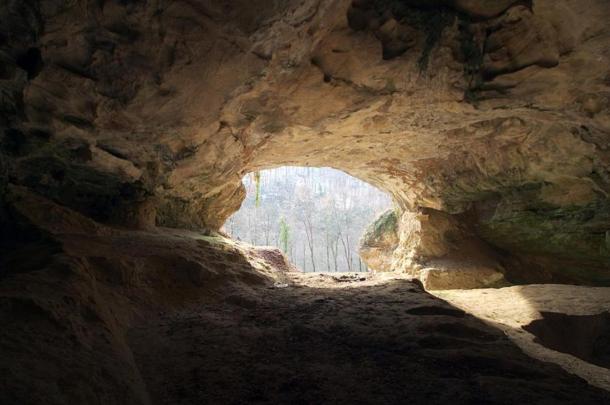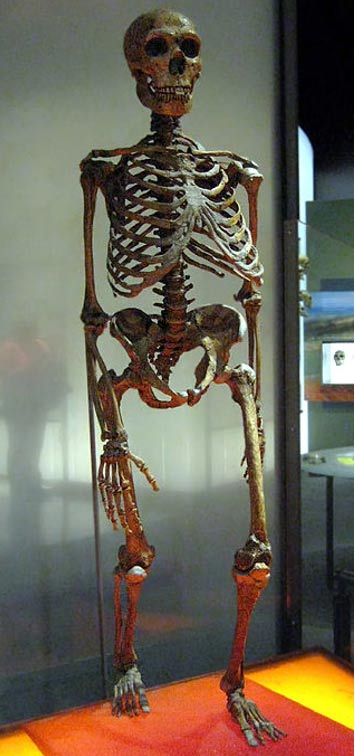
Jawbone shows Modern Human 40,000 years ago had Neanderthal Great-Great-Grandfather
The mysterious history of Neanderthals, and their relationship with the first modern humans eludes scientists, but current research is quickly filling in gaps, showing that Neanderthals were, and continue to be, an integral part of modern humanity. Our prehistoric cousins didn’t completely vanish from the earth, as their presence can still be identified within modern DNA. A study published this week in the journal Nature has revealed the highest percentage of Neanderthal DNA in any modern human ever studied.
A jawbone from a man who lived 40,000 years ago reveals that six to nine percent (up to 11 percent) of his genome is Neanderthal, the highest amount ever found in a modern human specimen, reports Discovery News.
This amazing find indicates that a Neanderthal was in his family as close as four generations back in his family tree—potentially his Great-Great Grandfather.
Modern individuals of European and Asian heritage have Neanderthal DNA in their genomes. But experts debate when this blending occurred, where, and whether Neanderthals were pressed into extinction by modern humans, or were assimilated through interbreeding, adoption, or raids.
- Neanderthal child remains found in Catalonia Cave
- 50,000-year-old Skull May Show Human-Neanderthal Hybrids Originated in Levant, not Europe as Thought
- New study suggests Neanderthals never went extinct

Wax model of a Neanderthal. Credit: Erich Ferdinand/Flickr
Research into ancient genomics and archaeology has shed light into the first humans in Europe, who appear in the record approximately 45,000 years ago. Neanderthals disappeared from the region 5,000 years later. The nature of their relationship is being revealed with every new discovery and breakthrough.
“The genome they sequenced from the samples was incomplete, but it was enough for the scientists to conclude that between 6% and 9% of Oase 1’s genome is Neanderthal in origin. People living today have 4% at most,” reports National Geographic.
An international team including institutes and researchers from Romania, Germany, USA and China studied the site where the fossil was found, and analyzed the DNA.
Senior study author Svante Pääbo of the Max Planck Institute for Evolutionary Anthropology in Leipzig explains the research team found “seven huge pieces of chromosomes that seemed to be purely of Neanderthal origin.” As each generation of parental chromosomes combine, they get broken up and reordered. The large nature of the pieces of chromosomes found in Oase 1 indicate they’d come from a relatively recent ancestor.
Oase 1 was a controversial find from the beginning. Discovered in 2002 in a cave system called Peștera cu Oase (The Cave with Bones) in south-western Romania, the shape of the male jawbone suggested it might be from a Homo sapien–Neanderthal hybrid.
These new genome findings lend weight to that theory.

Isolated caves in Europe, such as the Vindija Cave (Croatia) have revealed artifacts and human fossils, telling the story of our prehistoric past. Wikimedia Commons
Oase 1’s genealogical line of modern humans has since died out. Pääbo tells Discovery News that Oase’s people seem to have “disappeared.” No tools or other artifacts were found within the cave system, and researchers suspect they interacted closely with Neanderthals before going extinct themselves.
Qiaomei Fu, one of the lead researchers of the study tells Science Daily, "The data from the jawbone imply that humans mixed with Neanderthals not just in the Middle East but in Europe as well.”
- Did light-skinned, redheaded Neanderthal women hunt with the men?
- Neanderthals and Humans are 99.84 percent genetically identical – so where are the differences?
- Researchers claim Neanderthals were NOT a sub-species of modern humans
A study in 2014 published in the journal PLOS ONE suggests that Neanderthals didn’t go extinct at all. Rather they vanished gradually over time by interbreeding and assimilation with early humans. The study authors wrote, “Genetic studies now suggest that the debate on the demise of the Neanderthals needs to be reframed in terms of some degree of interbreeding.”
The authors concluded that “Neanderthals did not go extinct, even though their distinctive morphology did disappear.” Instead the Neanderthals were assimilated within the expanding human population.

Restoration of a Neanderthal woman cleaning a reindeer skin. (Wikimedia Commons)
Oxford’s Tom Higham, expert on the Neanderthal-human transition who was not involved in the 2015 study published in Nature says, “The great breakthrough here is the ability to say ‘this specific person had a Neanderthal great-great-grandfather.’ That puts a human timescale on it.”

A mounted Neanderthal skeleton. Wikimedia Commons
National Geographic concludes, “if scientists can figure out when interbreeding took place in different parts of Europe and the Middle East, they’ll be able to say in detail just how rapidly humans spread across these regions, how long they were in contact with Neanderthals—and maybe tell us at last why our nearest relatives vanished.”

A family of Neanderthals in Eurasia, during the Pleistocene epoch (Wikimedia Commons)
Featured Image: The Oase 1 jawbone from a 40,000-year-old modern human. The jawbone reportedly shares traits with Neanderthals, and now DNA reveals the man had a Neanderthal genetic heritage. Credit: Svante Pääbo, Max Planck Institute for Evolutionary Anthropology
Journal Reference:
- Qiaomei Fu, Mateja Hajdinjak, Oana Teodora Moldovan, Silviu Constantin, Swapan Mallick, Pontus Skoglund, Nick Patterson, Nadin Rohland, Iosif Lazaridis, Birgit Nickel, Bence Viola, Kay Prüfer, Matthias Meyer, Janet Kelso, David Reich, Svante Pääbo. An early modern human from Romania with a recent Neanderthal ancestor. Nature, 2015; DOI: 10.1038/nature14558
By Liz Leafloor















Comments
I real think we know the answer there are many people whom one meets that has teeth and facial structures that make them look like cave men ....I'd be willing to bet of you tested people with those traits now predominate forhead big scary teeth wide mouths...this is where the answer is there are a lot in South Dakota who have these looks we call them cave men with a laughing heart....
ajpete
Interbreeding, aka sex and other terms, happens daily and among humans of every kind. In every corner of the world we find every sort of human. Little ones, big ones, dark ones, light ones, and every gradation in between.
The whole theory of evolution arose in Victorian England, a country afraid of sex. Darwin knew that hybrid vigor applied in plants, but for cultural reasons, i.e. racism and classcism, he believed inbreeding made humans better so married his own first cousin.
Promiscuity, more than any other trait, defines humans. Smart ones, stupid ones, big ones, small ones, every kind of human engages in sex. And with any of the other kind whenever given the opportunity.
Neanderthal just indicate a variation in racial interbreeding. The more gracile ones have more Cro Magnon genes and the more “animalistic” looking ones less. Tons of sites have interbred Neanderthal and modern humans, from Israel to Spain.
Tom Carberry